Basmati rice:- The fragrant rice
What is Basmati rice:-
Basmati Rice is a type of long grain aromatic rice. According to Agricultural & Processed food products export development Authority, Ministry of commerce & Industry, Govt. of India (APEDA), any rice which has grown in the foothill of Himalayan region of Indian-subcontinent with a minimum average precooked milled rice length of 6.61mm & width of upto 2mm will be termed as Basmati Rice. Those rice that don’t meet these specific criteria will not be tagged as Basmati Rice.
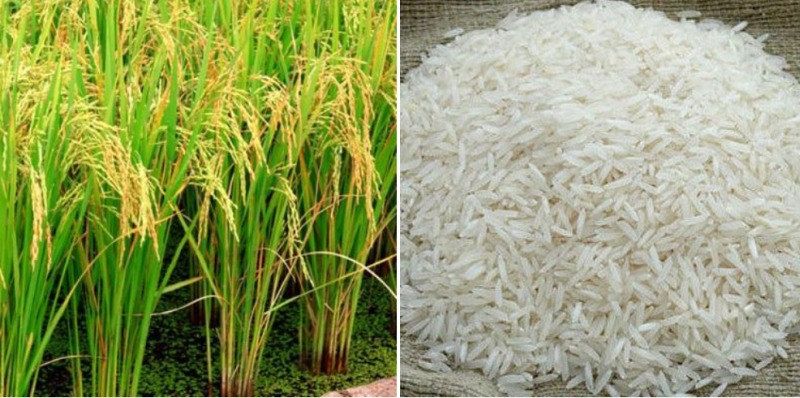
Pic source-Agri farming
The average length of this long grain basmati rice is around 6.61mm to 9.50 mm and its average width are1.3mm to 1.5mm which is 5 times shorter than its length.
The word Basmati derives from the Sanskrit word “vasmati”, meaning “fragrant”. In fact, the word “basmati” in Hindi means “full of aroma” or “fragrant.” In some places, it’s called the Queen of perfumed rice or Pearl of Rice.
Picture of extra long grain of Pusa 1121 Basmati rice variety
(The average length of Pusa 1121 basmati rice is around 8.5mm)


Pic source-Rice Xperts.com
This aromatic long grain basmati rice is grown only once in a year mainly in specific geographical area of Indo Gengetic plain at the foothill of Himalayan region of Indian sub-continent & little bit Himalayan region Pakistan. Foot hill of Himalayan region of Indian sub-continent is having ideal agro-climate conditions for the growth of True & Authentic Bastmati Rice which has unique characteristic of “Scented Pearl”, delicate taste & flavor, light nutty flavor & floral aroma etc.
Characteristic of Basmati Rice grain:-
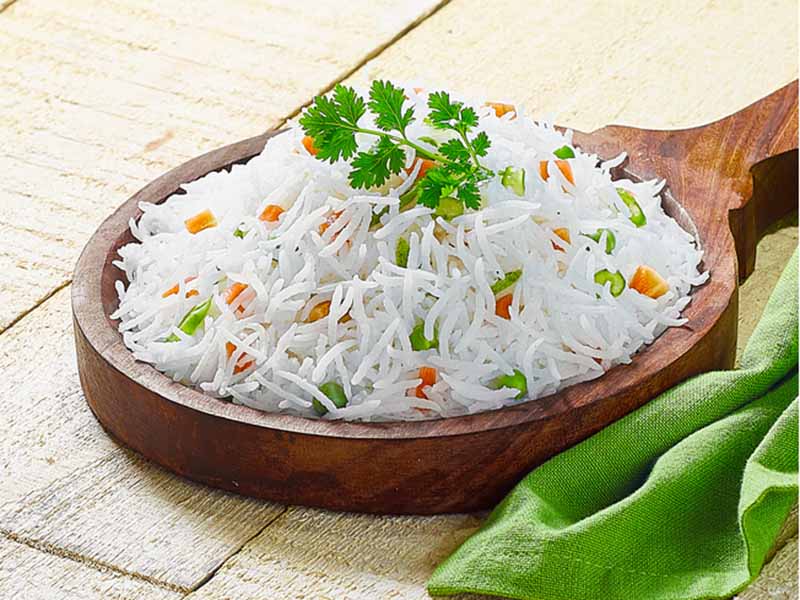
Pic source-Old school labs
True & authentic premium quality of basmati rice is only cultivated in the foothills of Himalayan region of Northern India in the world. True & authentic basmati rice will have the following characteristic-
Grain size of Basmati Rice:
- Minimum length of any basmati rice as per APEDA should be 6.61mm length & 1.33mm width
- Average grain of basmati rice is 7mm length & 1.5mm width
- Extra long grain of basmati Rice: – Length more than 7.50mm up to 9.42mm & width 1.5 mm to 2mm.
Elongation of grain upon cooking:-The most important characteristic of any Basmati Rice is its length elongated at least 2-2.5 times of its original length size upon cooking with least breadth‐wise swelling & imparts soft & fluffy texture, sweet delicious taste & floral aroma. That means if a raw basmati rice grain has a length of 6.61mm will turn its length upon cooking to 13.22mm-16.52mm.
Texture of grain: Upon cooking of basmati rice, the texture will be firm & tender without splitting or broking of cooked grains. Also the cooked basmati grain will be Non-sticky. This happens mainly due to the presence of “amylase” presence in basmati rice which is around 22-25% resulting the cooked basmati rice is Non-sticky characteristic.
Flavour profile:- Basmati rice has typical pandan like flavour (Pandanus amaryllifolius leaf) due to the naturally presence of 0.09 PPM of “2-acetyl-1-pyrroline” aroma compound in it which is around 12times more than Non-basmati rice variety making basmati rice a unique rice variety in the world.
Ageing:- It is believed that the older the rice, the better it is. Ageing enhances the attributes of basmati by reducing moisture content, increasing aroma, length, taste and cooking results. The rice which has been aged for 1–3 years is the consider best for consumption.
The rice has derived its name Basmati because of the aroma. In Hindi Bas means fragrance and hence it is named as Basmati.
History of cultivation of basmati Rice:-
Archeological evidence indicates that rice has been cultivated in India from between 1500-100BC. It has also been documented in our ancient text “Atharva-Veda”. Whereas one of the earliest mentioned of Basmati Rice is in the epic of Heer Ranjha composed in 1766.
Among the earliest mentions of Basmati rice is the one in the tragic Punjabi romance of Heer-Ranjha by the Punjabi Sufi, Waris Shah in 1766/1767.
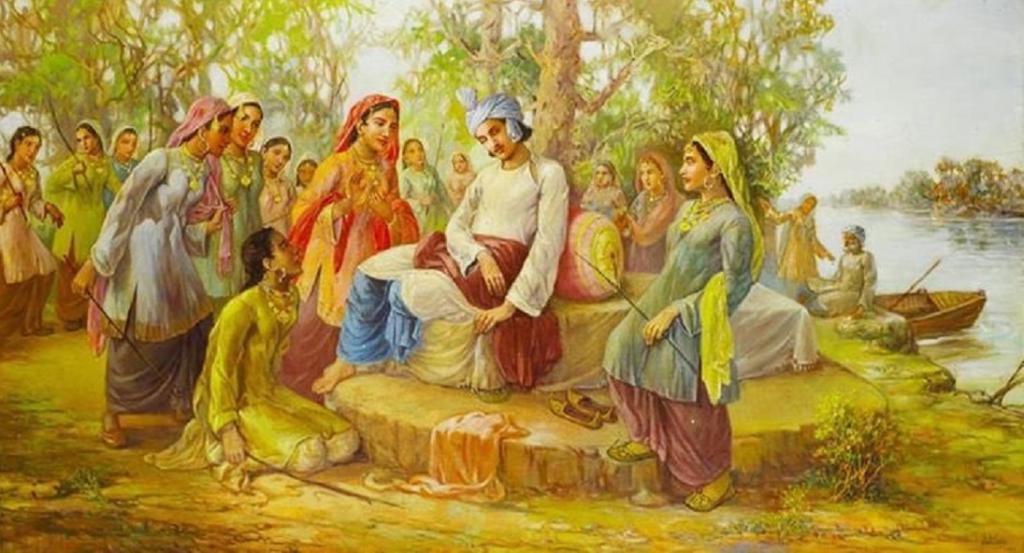
Pic source- downtoearth.org
According to Dr. Y.L Nene, Chairman, Asian Agri-history foundation & former deputy director general of the international crops research institute for semi-arid tropics (ICRISAT), Secunderabad, Andhra Pradesh. Basmati is most likely of medieval origin. The first record of Basmati Rice was seen in the Waris Shah poem written in Punjabi language:- “Heer Ranjha” in the year 1766. To get names of rice cultivars in the poem, the varieties should have been well known over an extended period. It is therefore to assume that Basmati word mentioned by Waris Shah must have been in Vogue for around 50-60 years. That means basmati rice variety should have been developed around 1700AD & growing years after year since then.
Indian traders introduced Basmati Rice to the Middle East through cultural exchange and since then it has become an important part of cuisine in Arab, Persian and other cuisines as well.
Basmati has been frequently referred to under the genus “Oryza” in “A Dictionary of the Economic Products of India” compiled by George Watt and published in 1891.
Climate condition & Soil Requirement:- Basmati rice crop evenly distributed rainfall throughout its growing time. It requires relatively cooler temperatures (25°C in day and 21°C at night) during crop maturity for better retention of aroma. Basmati varieties with superior cooking and eating characteristics can be produced if the crop matures in relatively cooler temperature.
The ideal soil require for basmati rice cultivation is clay & loamy soil because of its water holding properties. The soil should have 5.0-8.5 pH value for its better yield.
Basmati cultivation region in India:-
Basmati rice is mainly grown in the specific geographical area of Indo Gengetic plain at the foothill of Himalayan region confined to few states of India such as Jammu & Kashmir, Himachal Pradesh, Punjab, Haryana, Delhi, Uttrakhand & western Uttar pradesh.
Haryana being the major basmati rice cultivator state producing more than 60% of the total basmati rice production in India followed by Punjab state (29%), Uttar pradesh (24%) & other state (5%). India is the largest producer of basmati rice, accounting for over 70% of its output in the global basmati rice market. In 2018, its production attained almost 5.03 million tons.
What are the various types of Basmati Rice crop:-
As per Indian seed act 1966, a total of 29 varieties of Basmati Rice have been identified. Each basmati rice varieties is unique in terms of its flavor profile, appearance, taste & texture. Traditional Indian types include basmati 370, basmati 385, and basmati Ranbir singh pura (R.S.Pura) and Gujjar Chack area in Jammu province situated at the India-Pakistani border in Jammu and Kashmir state of India.
Some of the prominent varieties of Basmati rice are:-
- Pusa Basmati 1121:-it is a hybrid variety of basmati Rice also commonly known as Muchal basmati. This hybrid basmati rice variety was developed by Padma shree awardee Thakur Vijay Pal singh, Agriculture scientist and his student Ashok Kumar Sarial associated with India council of Agricultural research (ICAR) and released for commercial cultivation in kharif season of 2003.
Pusa basmati 1121 has extraordinary grain length of average raw grain length of 8.4mm. It has very high kernel elongation ration ranging from 2-2.5 times of its raw length and minimum width expansion after cooking. This extra long basmati rice is used specially for Biryani & pulao preparation.
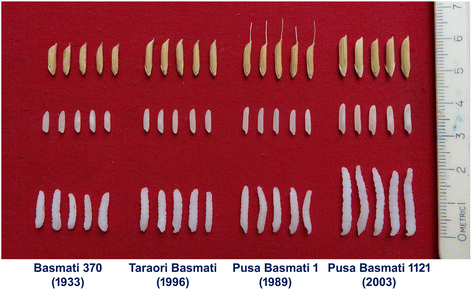
Pic source- thericejournal.springeropen.com
It is extensively cultivated in Punjab (84% of total basmati area), Western U.P (78% of total basmati area), Haryana (68% of total basmati area), Uttrakhand (30% of total basmati area), Jammu & Kashmir (08% of total basmati area) etc.
- Pusa Basmati 1509:-
This variety of basmati rice was developed to overcomes all the major weakness of Pusa basmati 1121 rice variety in the year 2013 by CVRC for the basmati growing region states like Punjab, Haryana, Delhi, Western UP, Uttrakhand , Jammu & Kashmir etc. This variety matures early as compare to Pusa basmati 1121 variety in just 115 days and its average yield are 5 tones per hectare.
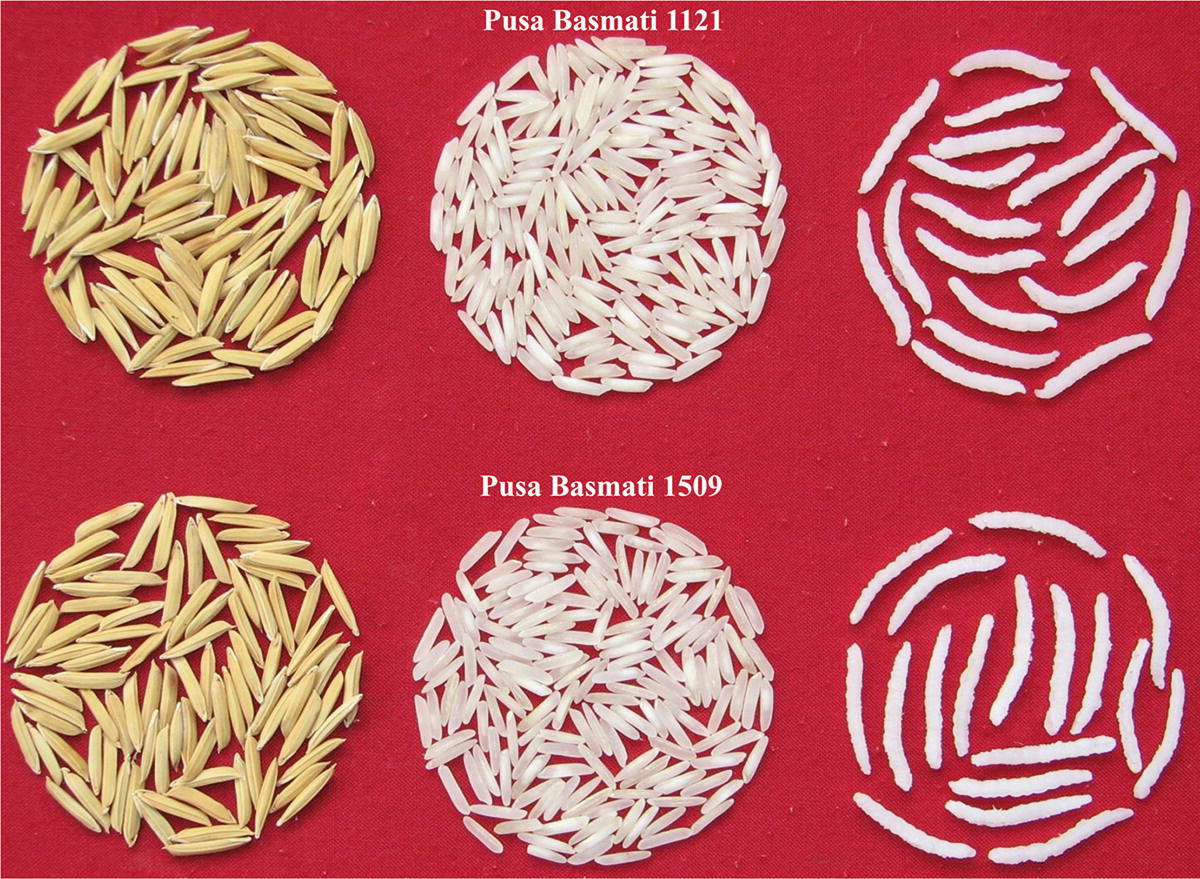
Pic source-springer link
- Ranbir Basmati :- This is relatively old variety of basmati rice that is mainly cultivated & consumed in Jammu & Kashmir as well as Dehradun area. The grains are exceptionally long with an exceptional aroma and taste which is why it is favoured by the locals.

Basmati 386 :- This is a premium variety of basmati rice and mainly known for doubling its length when cooked. It is very popular in market.
Taraori Basmati:- This is very popular in the Taraori region of Haryana where it is locally known as karnal basmati. It is considered as the oldest basmati rice variety which is cultivating since 1933 in Haryana state.This long grain basmati rice is aromatic and mainly popular for wedding & events party.
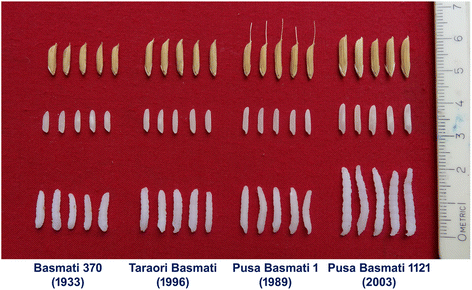
Pic source-Rice springer-open
Other common basmati rice variety are:- P3 Punjab, Muradabadi Basmati 6465, Basmati 198, Basmati 217, Basmati 370 Bihar, Kasturi, Mahi Suganda, Basmati 271, Dehraduni basmati type 3, Punjab basmati or Bauni basmati, Pusa basmati 1, Mahi Sugandha, Ranbir basmati, Pusa 1460, Vallabh basmati 22 etc.
Difference between brown basmati Rice & White basmati rice
| Brown basmati Rice | White basmati rice |
| The brown basmati rice is the whole grain of basmati rice without hull or husk but with germs, bran & endosperm intact. | White basmati rice is polished basmati rice produced by removing the husk, bran & germ during the milling process to produce the white basmati grain. |
| Brown basmati rice is full of nutrient .Its expensive than white rice. | White basmati rice is low in nutrient content due to absence of bran & germ. It is cheaper than brown basmati rice |
| Brown basmati rice is a natural whole grain rice which is not polished. | White basmati rice is polished rice |
| Brown rice is chewier than white rice, has a more nutty flavor. | White basmati rice is softer, fluffy texture, sweet delicious taste & floral aroma. |
| Brown basmati rice has more fiber content due to its bran & germ presence & bit tough to digest. | White basmati rice has less fiber than brown basmati rice (because the outer shell has been removed), therefore is much easier to digest. |
 | 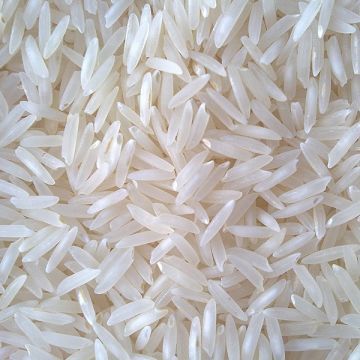 |
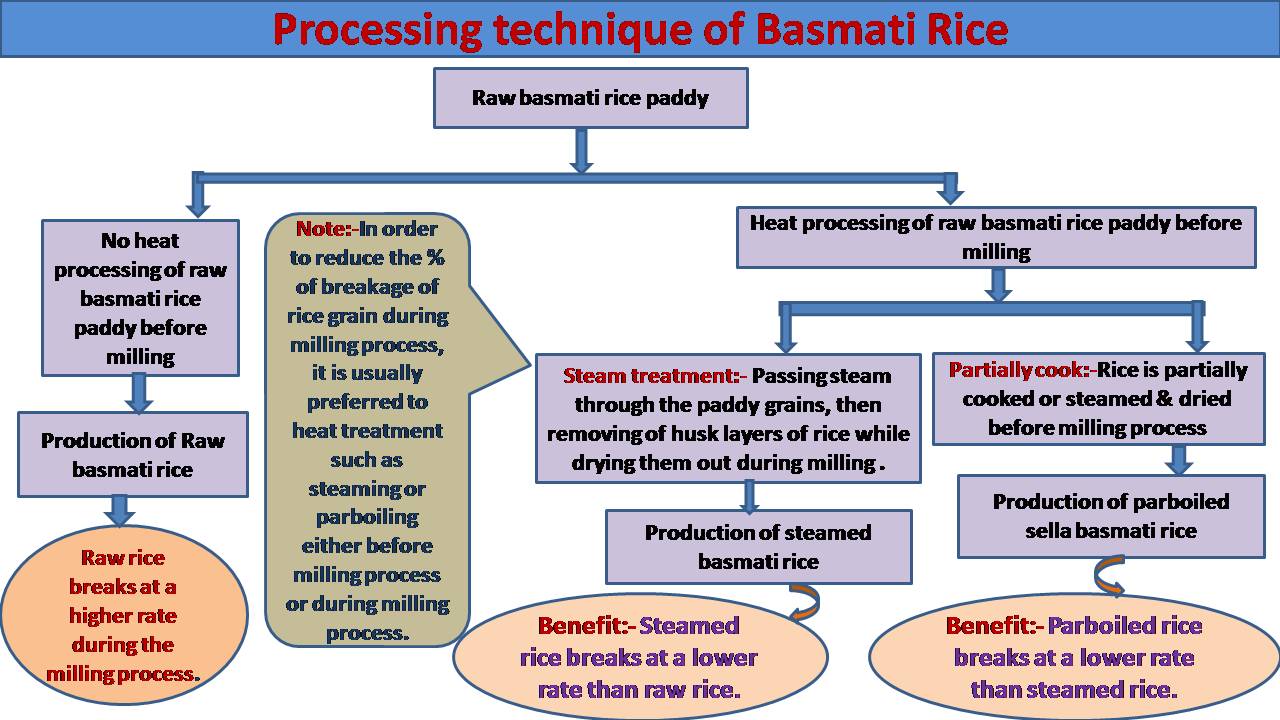
Harvesting
When the basmati rice crop ripens in around 3months of its plantation, it is ready for harvesting. Harvesting of basmati Rice paddy can be done either manually or by harvester machine depending upon the volume of production.
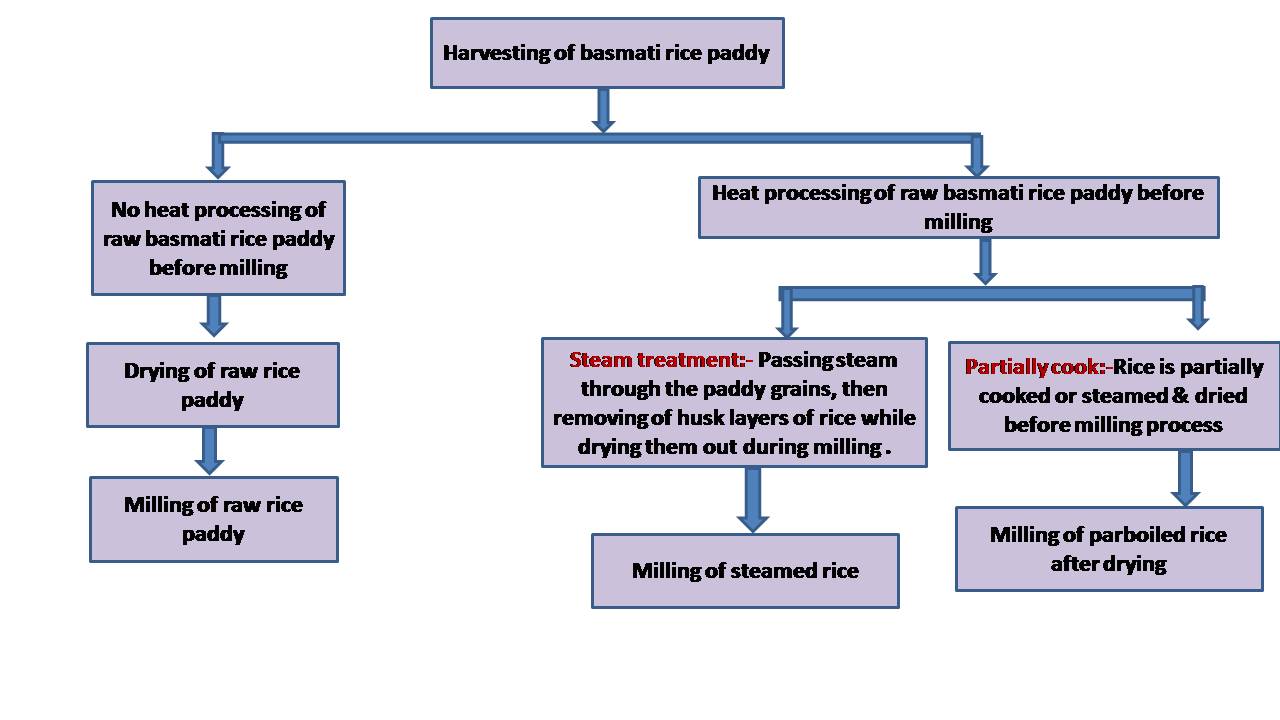
Steaming of basmati rice to produce Traditional basmati rice:-
In order to obtain Traditional basmati rice or steamed basmati rice, the rice paddy is passed though steaming process & then removing of its husk layers while drying them out during milling process. This steaming process help basmati rice to reduce the percentage of breaking its grain during milling as raw rice breaks at higher rate during the milling process.
Partially cooking or parboiling to produce Sella Rice:-
Partially cooking or parboiling of basmati rice within the husk before milling is mainly done to further reduce the percentage of breaking its grain during milling as parboiled rice breaks at a lower rate than steamed rice.
In India around 60% of rice is per-boiled because of its soft structure, the raw rice is very softer in nature and will be broken more during milling process along with loss in vitamin & minerals. Parboiling makes raw rice harder in nature resulting low breakage will occur during milling process. Golden Sella Basmati Rice is a cultivar of basmati rice that has been parboiled or partially boiled while still in its husk and then milled. So Golden Sella is actually parboiled basmati rice. The rice turns pale yellow after parboiling hence the name ‘Golden‘
Parboiled rice is therefore more nutritious than white rice. Parboiled rice takes a little bit longer to cook and does not stick to the pan during cooking. It is better than regular rice as it usually goes through a process where the starch gets stabilized•
What is the Science behind steaming or parboiling before milling :-
Partially cooking or parboiling of raw rice with husk hardens its rice grain starch. The rice starch is basically polymers of glucose monomers (C6H10O5)n which is colourless, tasteless & odourless & insoluble in cold water & alcohol but soluble in Hot water. The amylose starch found in rice grain(20-25% in linear helical structure, (C1-C4 Linkage) play a major role in gelatinization & Retro gradation of starch when rice is cooked or parboiled making basmati rice more strong upon drying and will result in less breakage of its grain during milling process.
No heat treatment to basmati rice before milling produce Raw basmati rice:-
To produce raw basmati rice, No heat treatment such as steaming or par-boiling is done with rice paddy before milling. It is simply sundried after harvesting & then milled. The raw white basmati rice will produce more broken rice grain due to very softy rice nature.
Drying:-
Once the rice is harvested, Heat or Not treated, it is then allow for proper drying in the sun in order to reduce the moisture content to the level of approx 13%. (Around 20 percent moisture is found in Basmati Rice at the time of harvesting) . Drying can also be done in artificially heated air where sunlight is not sufficient.
Hulling:-
Hulling is a process in which dried rice is rolled on with machine to remove the husk or hull from the rice. After hulling, the whole rice grain is obtained which has bran, germs & its endosperm intact in the rice gain. It is called brown basmati rice.
Milling:-
Since brown basmati rice is more prone to spoil, that is why it is polished further to remove its bran & germs to obtain white basmati rice. After removal of bran layer, it is polished to look more presentable.
In order to produce, white basmati rice, the hulled basmati rice is required to further polished so that its bran & germs is gently removed and only endosperm is left to produce white basmati rice.
Milling system can be either One step milling, 2-step milling process or Multistage milling process.
- One step milling – In this step, husk and bran removal are done in one pass
- Two-step process – In this step, removing the husk and removing bran are done separately
- Multistage milling – rice undergoes a number of different processing steps, such as:
Pre-cleaning, Dehusking or dehulling, Paddy separation, Whitening or polishing, Grading and separation of white rice
Enriching:-
Enriching is mainly done with white rice as it loose much of its vitamin & minerals which are mainly found in bran layers. The polished rice is replenished with some important nutrients & vitamins to make it more suitable for consumption.
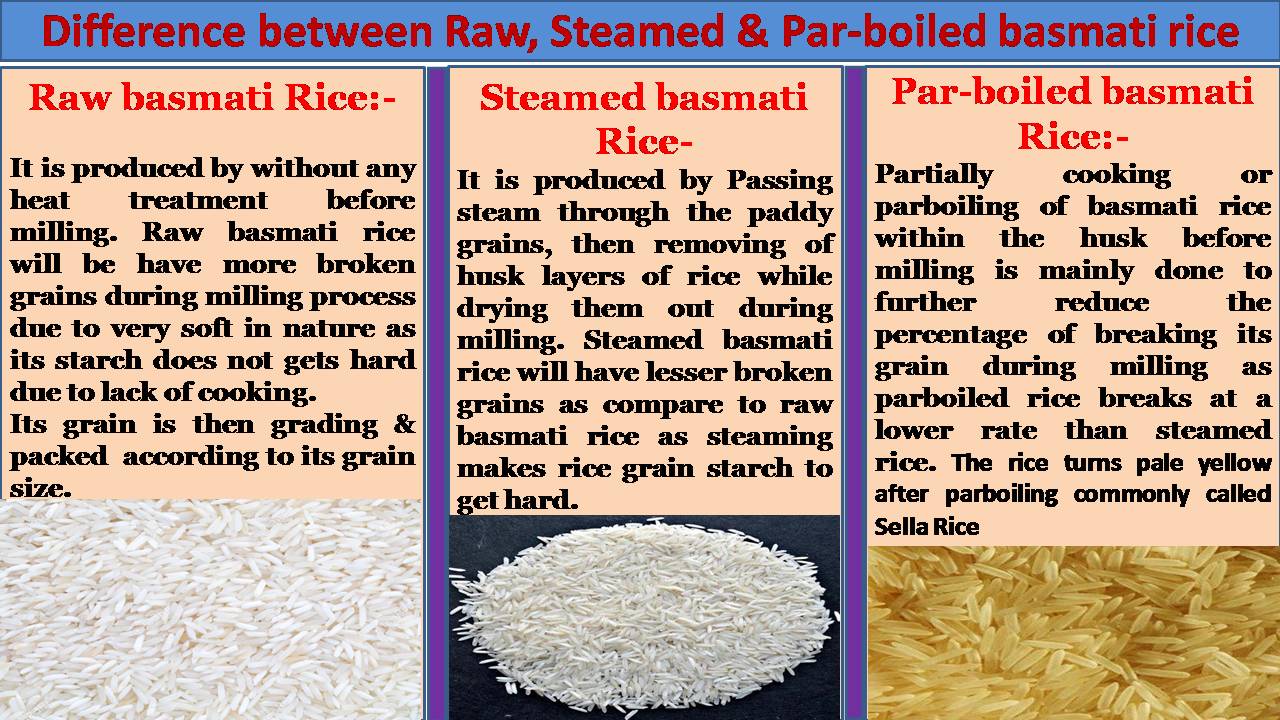
G.I Tag for Indian basmati Rice:-
On 11th Sept 2020, India has applied for exclusive Geographical Indication (G.I) Tag for long grain basmati Rice at European Union official registry, the council on quality scheme for agricultural products & food stuffs by mentioning that basmati is an Indian origin product.
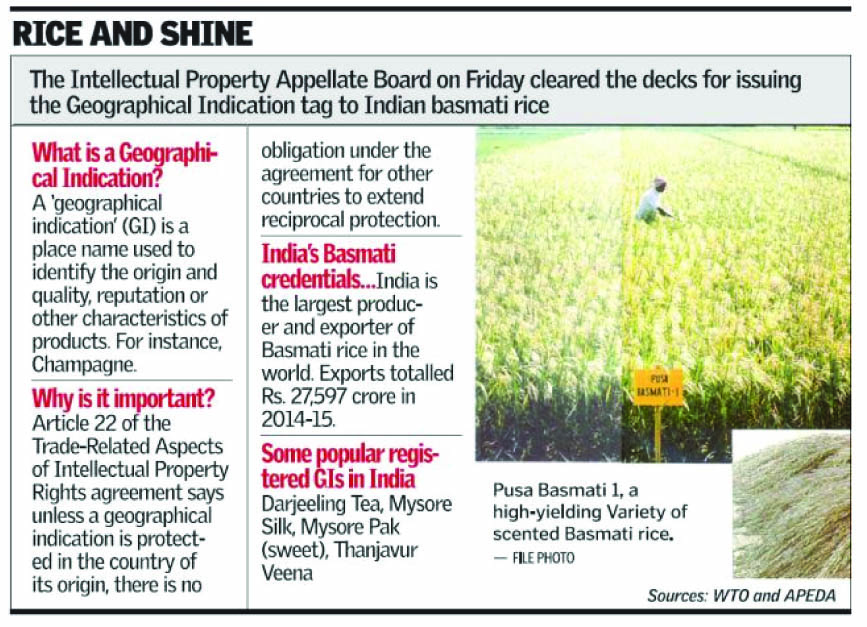
Source-the Hindu news
The Intellectual Property Appellate Board (IPAB) has ordered Chennai based Geographical Indications Registry (GIR) to issue “Geographical Indication” tag for basmati rice. This GI tag will be issued to basmati rice variety grown in 7 states in the Indo-Gangetic Plains (IGP) on the foothills of the Himalayas. These states are Punjab, Haryana, Himachal Pradesh, Uttarakhand,, Outskirt of Delhi, western Uttar Pradesh and Jammu & Kashmir. This tag will help to preserve the unique identity of India’s aromatic basmati rice in the international markets.
Export status of basmati rice from India:-
India is the one of the leading producer & exporter of Basmati rice in the world which accounts for 75% of global basmati rice production. During the FY 2018-19, India exported around 4.4 million tons of basmati rice worth of 4.7 billion US Dollor and expected to reach its export worth Rs 30,000 crore of rupees in the year 2020. India export basmati rice to almost 132 countries across the globe every year. Its major export destination countries are:- Saudi Arabia, UAE, Iran, Iraq, Kauwait, UK, USA etc.

Pic source-trade promotion councils.
Cooking technique & Use of basmati Rice:-
Basmati rice is the perfect accompaniment to Indian curries dishes and extensively used in the preparation of variety of rice dishes such as biriyani and pulao dishes. Delicious regional desserts such as Kheer, Sweet Saffron Rice and Phirni etc are also made from basmati rice. It is also used for making variety of Middle Eastern delicacies.
There are three common ways to cook basmati rice:-
- Drainage method –In this method, basmati rice is cooked by boiling in ample amount of water usually 4-5 times of weight of rice. Once the basmati rice is cooked, the boiling water is discarded by straining it. Both type of basmati rice i.e brown basmati rice & white basmati rice can be cooked by this common method.
- Absorption method – This is very popular method in which basmati rice is first toasted or sautéed in butter or ghee with whole Indian spices to impart typical flavour specially while making pulao or pilaf. It is then cooked in water usually 2-2.5times of its weight of rice so that all the cooking water get fully absorbed by basmati rice. To further impart the Indian spices flavour & aroma it is slightly put on dum at the last minute of its cooking.
Rice to water ratio for absorption cooking method
- Regular white basmati rice – 1 : 2
- Organic basmati rice – 1 : 2½
- Brown basmati rice – 1 : 3
- Parboiled basmati rice or sella basmati rice – 1:2½ to 3
- Steaming method:-steaming method is also very common method of cooking white basmati rice either in a rice steam cooker or in direct contact with steam. White basmati rice needs to be soaked for at least 15-20 minutes before steaming.
Nutritional value of basmati Rice:-
Basmati Rice is gluten free & cholesterol free rice and it contains all 8 essential amino acids. It is also low in fat content & sodium content. Basmati has a low to medium glycemic index, meaning that energy is released at a slower, steadier rate leading to a more balanced level of energy.
According to health line, One cup (163 grams) of cooked white basmati rice contains
- Calories: 210
- Protein: 4.4 grams
- Fat: 0.5 grams
- Carbs: 45.6 grams
- Fiber: 0.7 grams
- Sodium: 399 mg
- Folate: 24% of the Daily Value (DV)
- Thiamine: 22% of the DV
- Selenium: 22% of the DV
- Niacin: 15% of the DV
- Copper: 12% of the DV
- Iron: 11% of the DV
- Vitamin B6: 9% of the DV
- Zinc: 7% of the DV
- Phosphorus: 6% of the DV
- Magnesium: 5% of the DV
Ref:-
Journal of Pharmacognosy and Phytochemistry 2017; SP1: 816-819 on basmati rice:-pride of india written by principal scientist, Basmati export development foundation, APEDA.
Article on Basmati rice:-A new hope for farmers by Sh. Anurag Bara, Dept of agronomy, Vidhan Chandra krishi vishwavidalaya, West Bengal
https://thericejournal.springeropen.com/
http://hafed.gov.in/
https://ifst.onlinelibrary.wiley.com/(Institute of food science technology)
healthline.com
